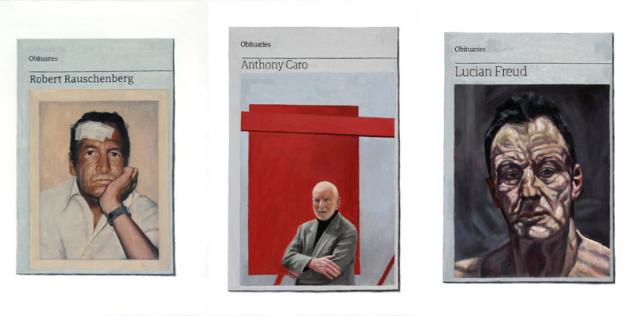Hugh Mendes is to exhibit his obsessional obituary paintings in a new show at Charlie Smith London. Operating simultaneously as portraits and still life paintings, these works are contemporary memento mori, serving as reminders of our mortality to both artist and audience. Being obituaries of deceased artists only, this is Mendes’ most personal exhibition to date. They are wistful, ritualistic memorials to artists that Mendes has known and / or admired, including Anthony Caro, Lucian Freud, Chris Burden and Robert Rauschenberg.
Beyond a rendition of a given subject, Mendes’ practice is an investigation into the process of image making, exploring both historical and modern strategies. Walter Benjamin states in The Work of Art in the Age of Mechanical Reproduction:
“The uniqueness of a work of art is inseparable from its being imbedded in the fabric of tradition. This tradition itself is thoroughly alive and extremely changeable.”
Mendes engages with 16th century Dutch still life painting; portrait painting from Vermeer to Gerhard Richter; Andy Warhol’s disaster and headline series; historical and contemporary photography; and mass reproduction in the form of newspaper and digital media. Predominantly, a Mendes obituary is composed of a painting of a photograph of his subject in combination with text, and a subtle allusion to the notion of still life by employing a drop shadow to suggest a newspaper cutting. However, within this collection, we often find an artist represented by their artwork, and so the subject is a photograph of an artwork, which has been filtered through the newspaper medium. Both manual and mechanical reproduction must be considered an essential component of his work, therefore.
This calls to question notions of authorship. Roland Barthes in The Death of the Author:
“We know now that a text is not a line of words releasing a single “theological” meaning (the ‘message’ of the Author-God) but a multi-dimensional space in which a variety of writings, none of them original, blend and clash. The text is a tissue of quotations drawn from the innumerable centres of culture.”
The generational nature of Mendes’ paintings, both in the means of production as well as reference points, illustrates this, positioning him very much in a post-modern context. By adopting a methodology that involves interacting with sequential images and across media, he simultaneously affirms and denies authorship. The aura of the original is negated as that of the new object emerges.
Hugh Mendes was born in Germany in 1955. He graduated with an MA in Fine Art from City and Guilds of London Art School, London in 2001 after reading a BA (Hons) in Fine Art from Chelsea School of Art 1975-78. Mendes has shown globally including Museum der Moderne, Salzburg; Torrance Ar Museum, Los Angeles; Klaipėda Culture Communication Centre, Klaipėda; Hales Gallery, London; Gusford, Los Angeles; KENNY SCHACHTER / ROVE, London; Wooster Projects, New York; and Raid Projects, Los Angeles. His work is placed in prominent collections including Peter Nobel, Jerry Hall, and Bill Wyman.

